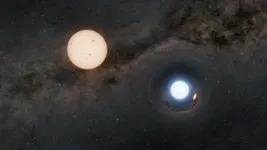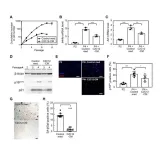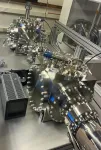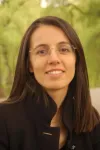(Press-News.org)
Most stars in our universe come in pairs. While our own Sun is a loner, many stars like our Sun orbit similar stars, while a host of other exotic pairings between stars and cosmic orbs pepper the universe. Black holes, for example, are often found orbiting each other. One pairing that has proved to be quite rare is that between a Sun-like star and a type of dead star called a neutron star.
Now, astronomers led by Caltech's Kareem El-Badry have uncovered what appear to be 21 neutron stars in orbit around stars like our Sun. Neutron stars are dense burned-out cores of massive stars that exploded. On their own, they are extremely faint and usually cannot be detected directly. But as a neutron star orbits around a Sun-like star, it tugs on its companion, causing the star to shift back and forth in the sky. Using the European Space Agency's Gaia mission, the astronomers were able to catch these telltale wobbles to reveal a new population of dark neutron stars.
"Gaia is continuously scanning the sky and measuring the wobbles of more than a billion stars, so the odds are good for finding even very rare objects," says El-Badry, an assistant professor of astronomy at Caltech and an adjunct scientist at the Max Planck Institute for Astronomy in Germany.
The new study, which includes a team of co-authors from around the world, was published in The Open Journal for Astrophysics. Data from several ground-based telescopes, including the W. M. Keck Observatoryon Maunakea, Hawai‘i; La Silla Observatory in Chile; and the Whipple Observatory in Arizona, were used to follow up the Gaia observations and learn more about the masses and orbits of the hidden neutron stars.
While neutron stars have previously been detected in orbit around stars like our Sun, those systems have all been more compact. With little distance separating the two bodies, a neutron star (which is heavier than a Sun-like star) can steal mass away from its partner. This mass transfer process makes the neutron star shine brightly at X-ray or radio wavelengths. In contrast, the neutron stars in the new study are much farther from their partners—on the order of one to three times the distance between Earth and the Sun.
That means the newfound stellar corpses are too far from their partners to be stealing material from them. They are instead quiescent and dark. "These are the first neutron stars discovered purely due to their gravitational effects," El-Badry says.
The discovery comes as somewhat of a surprise because it is not clear how an exploded star winds up next to a star like our Sun.
"We still do not have a complete model for how these binaries form," explains El-Badry. "In principle, the progenitor to the neutron star should have become huge and interacted with the solar-type star during its late-stage evolution." The huge star would have knocked the little star around, likely temporarily engulfing it. Later, the neutron star progenitor would have exploded in a supernova, which, according to models, should have unbound the binary systems, sending the neutron stars and Sun-like stars careening in opposite directions.
"The discovery of these new systems shows that at least some binaries survive these cataclysmic processes even though models cannot yet fully explain how," he says.
Gaia was able to find the unlikely companions due to their wide orbits and long periods (the Sun-like stars orbit around the neutron stars with periods of six months to three years). "If the bodies are too close, the wobble will be too small to detect," El-Badry says. "With Gaia, we are more sensitive to the wider orbits." Gaia is also most sensitive to binaries that are relatively nearby. Most of the newly discovered systems are located within 3,000 light-years of Earth—a relatively small distance compared, for example, to the 100,000 light-year-diameter of the Milky Way Galaxy.
The new observations also suggest just how rare the pairings are. "We estimate that about one in a million solar-type stars is orbiting a neutron star in a wide orbit," he said.
El-Badry also has an interest in finding unseen dormant black holes in orbit with Sun-like stars. Using Gaia data, he has found two of these quiet black holes hidden in our galaxy. One, called Gaia BH1, is the closest known black hole to Earth at 1,600 light-years away.
"We don't know for sure how these black hole binaries formed either," El-Badry says. "There are clearly gaps in our models for the evolution of binary stars. Finding more of these dark companions and comparing their population statistics to predictions of different models will help us piece together how they form."
The paper titled "A population of neutron star candidates in wide orbits from Gaia astrometry" was funded by the National Science Foundation, the European Research Council, and the Gordon and Betty Moore Foundation. Other Caltech authors include graduate student Natsuko Yamaguchi and Professor of Astronomy Andrew Howard. Additional authors include Hans-Walter Rix and René Andrae of the Max-Planck Institute for Astronomy, David Latham and Allyson Bieryla of the Center for Astrophysics/Harvard & Smithsonian, Sahar Shahaf of the Weizmann Institute for Science, Tsevi Mazeh of Tel Aviv University; Lars Buchhave of the Technical University of Denmark, Howard Isaacson of UC Berkeley and University of Southern Queensland; Alessandro Savino of UC Berkeley, and Ilya Ilyin of Leibniz Institute for Astrophysics Potsdam.
END
“[...] the present results strongly suggest the potential of PEDF as a myokine linking exercise training to the suppression of senescence.”
BUFFALO, NY- July 16, 2024 – A new research paper was published on the cover of Aging (listed by MEDLINE/PubMed as "Aging (Albany NY)" and "Aging-US" by Web of Science) Volume 16, Issue 13, entitled, “Roles of pigment epithelium-derived factor in exercise-induced suppression of senescence and its impact on lung pathology in mice.”
Senescent cells contribute ...
“[...] we found an independent positive prognostic effect of HER2-low compared to HER2-zero in early breast cancer.”
BUFFALO, NY- July 16, 2024 – A new editorial paper was published in Oncotarget's Volume 15 on June 20, 2024, entitled, “HER2-low and HER2-zero in breast cancer between prognosis, prediction and entity.”
In this new editorial, researchers Marcus Schmidt, Hans-Anton Lehr, and Katrin Almstedt from the University Medical Center of Johannes Gutenberg University discuss HER2 in breast cancer. HER2 is a well-established prognostic and predictive factor in breast ...
CAMBRIDGE, MA — Foundation models are massive deep-learning models that have been pretrained on an enormous amount of general-purpose, unlabeled data. They can be applied to a variety of tasks, like generating images or answering customer questions.
But these models, which serve as the backbone for powerful artificial intelligence tools like ChatGPT and DALL-E, can offer up incorrect or misleading information. In a safety-critical situation, such as a pedestrian approaching a self-driving car, these mistakes could have serious consequences.
To help prevent such mistakes, researchers from MIT and the MIT-IBM Watson AI Lab developed a technique to estimate the reliability ...
WASHINGTON, D.C. - Today, the U.S. Department of Energy (DOE) and the Defense Advanced Research Projects Agency (DARPA) announce a Memorandum of Understanding (MOU) to coordinate efforts to move the needle on quantum computing.
“Realizing practical quantum computers has the potential to dramatically accelerate the pace of discovery across the science and technology landscape,” said Ceren Susut, DOE Associate Director of Science for the Advanced Scientific Computing Research program. “The Office of Science is proud to bring decades of experience in fundamental science for quantum ...
Each cell in the body has its own unique delivery system that scientists are working on harnessing to move revolutionary biological drugs — molecules like proteins, RNA and combinations of the two — to specific diseased parts of the body.
A new study from Northwestern University hijacked the transit system and sent tiny, virus-sized containers to effectively deliver an engineered protein to its target cell and trigger a change in the cell’s gene expression. The success came from encouraging engineered proteins to move toward a specific cell membrane structure that the researchers found increased a protein’s likelihood of latching onto the container.
Published ...
SAN ANTONIO — July 16, 2024 — Researchers from Southwest Research Institute (SwRI) and The University of Texas at Dallas (UTD) are collaborating to evaluate a next-generation sensor designed to measure neutral gas velocities in the Earth’s upper atmosphere. The project, led by SwRI’s Dr. Joo Hwang and UTD’s Dr. Phillip Anderson, is supported by a grant from the new SwRI/UTD Seed Projects for Research, INnovation, and Technology (SPRINT) Program. Another SPRINT project is researching domestic lithium independence, looking at ...
AMHERST, Mass. – A new global assessment of scientific literature led by researchers at the University of Massachusetts Amherst finds that nature-based solutions (NbS) are an economically effective method to mitigate risks from a range of disasters—from floods and hurricanes to heatwaves and landslides—which are only expected to intensify as Earth continues to warm.
NbS are interventions where an ecosystem is either preserved, sustainably managed or restored to provide benefits to society and to nature. For instance, they can mitigate risk from a natural disaster, or facilitate climate mitigation and adaptation. NbS ...
July 16, 2024-- A new report from Columbia University Mailman School of Public Health and the Columbia Aging Center with colleagues from the Norwegian Institute of Public Health highlights a troubling trend: while global adolescent fertility rates have significantly declined, sub-Saharan Africa is experiencing an increase in teen births. This region's share of global adolescent births surged from 12 percent in 1950 to 47 percent in 2020 and is projected to reach a clear majority – a full 67 percent - by ...
New research at the University of Illinois Chicago is testing whether digital tools can help predict which patients with depression will benefit from specific treatments and help deliver those treatments to them on demand.
Two new grants awarding over $10 million to UIC will help Dr. Jun Ma and colleagues in the College of Medicine investigate the use of a smartphone app, an AI voice assistant and other technologies to diagnose and treat depression.
The researchers hope these tools will both broaden access to psychiatric care and ...
The human brain is responsible for critical functions, including perception, memory, language, thinking, consciousness, and emotions.
To understand how the brain works, scientists often use neuroimaging to record participants’ brain activity when the brain is performing a task or at rest. Brain functions are systematically organized on the cerebral cortex, the outer layer of the human brain. Researchers often use what is called a "cortical surface model" to analyze neuroimaging data and study the functional organization of the ...




